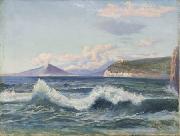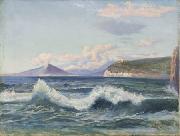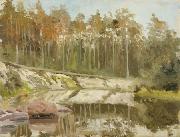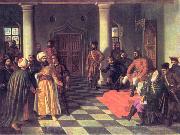Amandus Adamson El petróleo que Pinta la ReproducciónAll Amandus Adamson Oil Paintings(12 November 1855, Uuga-Rätsepa, near Paldiski -26 June 1929, Paldiski) was an Estonian sculptor and painter. Born into a seafaring family, Adamson excelled in wood carving as a child. He moved to St. Petersburg in 1875 to study at the Imperial Academy of Arts under Alexander Bock. After graduation he continued to work as a sculptor and teacher in St. Petersburg, with an interruption from 1887 through 1891 to study in Paris and Italy, influenced by the French sculptors Jules Dalou and Jean-Baptiste Carpeaux. Adamson produced his best-known work in 1902. His Russalka Memorial, dedicated to the 177 lost sailors of the Ironclad warship Russalka, features a bronze angel on a slender column. The other work is architectural. His four allegorical bronzes for the Eliseyev department store in St. Petersburg (for architect Gavriil Baranovsky), and the French-style caryatids and finial figures for the Singer House (for architect Pavel Suzor) are major components of the "Russian Art Nouveau" visible along Nevsky Prospekt. |
|||

|
|||
|
|
|||
|
||||||||
| Amandus Adamson (12 November 1855, Uuga-Rätsepa, near Paldiski -26 June 1929, Paldiski) was an Estonian sculptor and painter. Born into a seafaring family, Adamson excelled in wood carving as a child. He moved to St. Petersburg in 1875 to study at the Imperial Academy of Arts under Alexander Bock. After graduation he continued to work as a sculptor and teacher in St. Petersburg, with an interruption from 1887 through 1891 to study in Paris and Italy, influenced by the French sculptors Jules Dalou and Jean-Baptiste Carpeaux. Adamson produced his best-known work in 1902. His Russalka Memorial, dedicated to the 177 lost sailors of the Ironclad warship Russalka, features a bronze angel on a slender column. The other work is architectural. His four allegorical bronzes for the Eliseyev department store in St. Petersburg (for architect Gavriil Baranovsky), and the French-style caryatids and finial figures for the Singer House (for architect Pavel Suzor) are major components of the "Russian Art Nouveau" visible along Nevsky Prospekt. |
||||||||
|
|
||||||||
| Pintura identificación:: 75159 Bay of Naples English: Bay of Naples Italiano: Golfo di Napoli Date 1896(1896) Medium Oil on canvas Dimensions 39.7 X 52 cm (15.63 X 20.47 in) cyf |
||||||||
|
|
||||||||
| Pintura identificación:: 75536 Bay of Naples Date 1896(1896) Medium Oil on canvas Dimensions 39.7 X 52 cm (15.6 X 20.5 in) cyf |
||||||||
|
|
||||||||
| Pintura identificación:: 75511 Evening in Suur Date 1890s - 1900s Medium Oil on canvas Dimensions 23.2 X 33.5 cm (9.1 X 13.2 in) cyf |
||||||||
|
|
||||||||
| Pintura identificación:: 75512 Evening near Paldiski Date 2nd half of 1890s - 1910s Medium Oil on canvas Dimensions 32.5 X 45.3 cm (12.8 X 17.83 in) cyf |
||||||||
|
|
||||||||
| Pintura identificación:: 85757 Vlad the Impaler and the Turkish Envoys Medium Oil on canvas cyf |
||||||||
|
|
||||||||
| ARTISTA PREVIO PROXIMO ARTISTA | ||||||||
|
|
||||||||
|
Amandus Adamson (12 November 1855, Uuga-Rätsepa, near Paldiski -26 June 1929, Paldiski) was an Estonian sculptor and painter. Born into a seafaring family, Adamson excelled in wood carving as a child. He moved to St. Petersburg in 1875 to study at the Imperial Academy of Arts under Alexander Bock. After graduation he continued to work as a sculptor and teacher in St. Petersburg, with an interruption from 1887 through 1891 to study in Paris and Italy, influenced by the French sculptors Jules Dalou and Jean-Baptiste Carpeaux. Adamson produced his best-known work in 1902. His Russalka Memorial, dedicated to the 177 lost sailors of the Ironclad warship Russalka, features a bronze angel on a slender column. The other work is architectural. His four allegorical bronzes for the Eliseyev department store in St. Petersburg (for architect Gavriil Baranovsky), and the French-style caryatids and finial figures for the Singer House (for architect Pavel Suzor) are major components of the "Russian Art Nouveau" visible along Nevsky Prospekt. |
||||||||
|
|
||||||||
|
CONTACTE EEUU |










